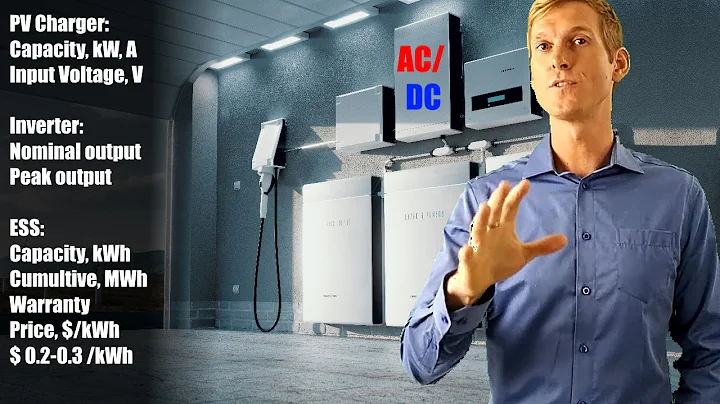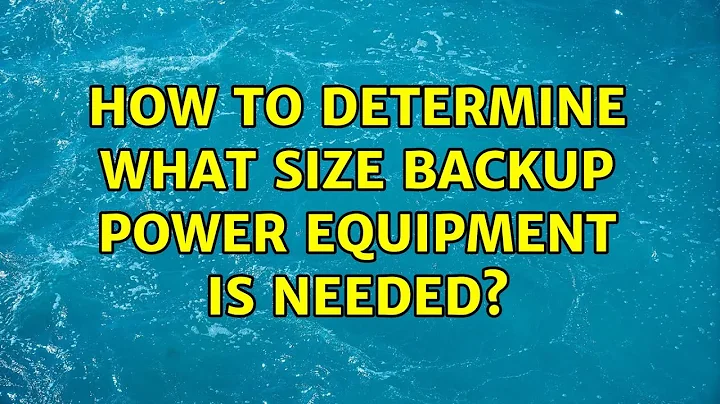How to determine what size backup power equipment is needed?
Solution 1
With a quick Google I find I can get a 800W "modified sinewave" inverter for $65. It claims "up to" 95% efficiency (though I'd assume maybe 60%) and has undervoltage alarm and shutdown.
Figure (conservatively) your load is 400W, or about 33A at 12 V. Multiplying for the efficiency we get about 20A. So, for 6 hours you need about 120AH battery capacity.
Sears lists trolling motor batteries at 80AH for $100, so two of those, in parallel, should do the job. You can probably go cheaper if you use auto batteries, but they're not "deep discharge" and will fail sooner if drained too far. Or, better, go with 2 6V "deep discharge" batteries in series for maybe an extra $50, but a lot more capacity.
Throw in another $30 for a decent battery charger, if the inverter does not supply that function, and you're up to about $300.
One other point: Lead-acid batteries give off flammable gas while charging and have been known to catch fire or explode under various circumstances. The batteries should be placed in a reasonably well ventilated area (not a closet) and away from other flammables, and should ideally be surrounded by a (lightweight) shield or cage to contain them in the case of an explosion.
Solution 2
For your use case, where you seem to be expecting extended outages, I would actually recommend trying to get a diesel generator with a small UPS (while you start it up) if possible, or maybe even consider batteries designed for solar power, with the added advantage of saving on future power costs ;)
When you're picking out any kind of power supply, you usually want to look at VA (Volt-Amps), not W (Watts). Nominally, W = V (Volts) * A (Amps), but Watts don't account for "unused" power that's "returned"1. You need to pick a supply that's capable of supplying the peak load you can expect, and a little extra. It also needs to be able to supply an adequate continuous load.
That sorts out whether the power supply is capable of supporting your usage. Then you need to look a the capacity, which determines how long the power supply can last with your usage. This is normally measured in Wh (Watt-hours, where 1 WH = 1 Watt for 1 hour) or kWh (kilowatt-hours, 1 kWh = 1000 Wh). To figure out how much you need, you take your continuous load and multiply it by the time you need, with some extra.
Performing the actual calculations with your data:
Your laptop will likely draw 150 W at peak, but far less when idling. I don't have that data, so I'm going to assume a 150 W continuous load. Add in the lights and fan and we reach almost 300 W (rounding and safety). We can usually approximate VA with 1 VA = 0.7 W, though this can vary a lot depending on what the equipment is. 60%-70% is the typical ratio2, and I'm using 70% here. Therefore, we reach about 430 VA. Let's say 450 VA. Remember, this is the value you cannot exceed - so this supply will never support more than about 300 W safely.
At this point you're looking for a power source that can supply at least 450 VA. Next step is to calculate the capacity - 300 W for 6 hours is 300 * 6 = 1600 Wh, or 1.6 kWh. That would require a pretty beefy battery from a UPS. Also note that batteries do degrade over time and will lose capacity and need to be replaced. Again, you might want to add a safety margin, maybe an extra hour. With capacity, if you draw more power it'll just last shorter, and vice versa.
Again, I don't have actual figures for your real continuous load. But you can repeat these calculations with adjusted values.
1 See What is the practical difference between watts and VA (volt-amps)?
2 Some loads, including some 80+ certified SMPSes, can almost reach a one-to-one ratio (1 VA > 0.9 W). But it's safer to assume lower than the other way around, unless you can measure and confirm.
Solution 3
You take watts times hours to get watt-hours. (W * H = WH)
Then you must include something for power inefficiencies, like for example say you need 1kw-hour. So you might want to actually supply 1.3kwh.
Batteries are typically rated in watt hours.
One option to get a more accurate snapshot of your actual usage would be to plug in a Kill-a-watt meter. It would also be helpful to watch how much you have used so far when you are in battery mode.
Solution 4
18+18+80=118w At 120v@1 amps is roughly 19v@6 amps. Due to inefficiencies in the conversion process about 1.3 amps or 156w. So 274 continuous watts. (Volts * Amps = Watts). 274w *6 hours = 1.6Kwh of power.
Going here: for store bought models instead of DIY:
Enter 300w and 6 hours with 10% overhead on there website.
http://www.apc.com/tools/ups_selector/US/en/home/load
You will need to spend $1500-$2500. Each of the suggested units has numerous expansion batteries up to 8 of them depending on the model.
Related videos on Youtube
MrClan
Updated on September 18, 2022Comments
-
MrClan over 1 year
I want to have an optimum continuous supply for my small office for 6hours, which includes, a laptop (AsusG73SW-> 8Cells : 5200 mAh 74 Whrs; Output : 19 V DC, 6.3 A, 150 W; Input: 100-240 V AC, 50/60 Hz universal) and 2 CFLs (18W each) and a fan(80W).
What configurations (specifications) would you recommend? How are the calculations done? A logical explanation is greatly appreciated. Thanks.
-
Daniel R Hicks over 10 yearsAdd up the watts, compute total watt-hours you need. Get a UPS that can provide the peak watts and which has a watt-hour rating probably 50% more than your requirements.
-
 tvdo over 10 years@DanielRHicks UPSes are normally rated in Volt-Amps for peak load (i.e. do not exceed, even when on mains), and SOHO ones typically have very limited battery capacity. Volt-Amps translate to a slightly lower number of Watts.
tvdo over 10 years@DanielRHicks UPSes are normally rated in Volt-Amps for peak load (i.e. do not exceed, even when on mains), and SOHO ones typically have very limited battery capacity. Volt-Amps translate to a slightly lower number of Watts. -
MrClan over 10 yearswhat does VA mentioned on batteries mean ?
-
 tvdo over 10 yearsAlso, at the moment this question reads like a product-rec/shopping question, which are usually closed. You can probably save it by emphasising the method of choosing a UPS, and preferably removing the request for a specific "model".
tvdo over 10 yearsAlso, at the moment this question reads like a product-rec/shopping question, which are usually closed. You can probably save it by emphasising the method of choosing a UPS, and preferably removing the request for a specific "model". -
 tvdo over 10 years@MrClan Watts (W) literally equal Volts (V) x Amps (A), but Volt-Amps (VA) normally means a slightly different thing. It's explained pretty well here, but basically VA refers more to how much power is traveling through the wire, and W more to how much power is "consumed"/"used" (dissipated) at the end. As the linked answer states, some of the VA power is actually returned back to the source "unused", making W lower than VA.
tvdo over 10 years@MrClan Watts (W) literally equal Volts (V) x Amps (A), but Volt-Amps (VA) normally means a slightly different thing. It's explained pretty well here, but basically VA refers more to how much power is traveling through the wire, and W more to how much power is "consumed"/"used" (dissipated) at the end. As the linked answer states, some of the VA power is actually returned back to the source "unused", making W lower than VA. -
 tvdo over 10 yearsVA is important when calculating how much max you can have flowing through a wire (or UPS) before something melts or gets damaged, while W is how much power you've used and need to pay for. A somewhat conservative bet for computing loads is W = 70% of VA. Something like a fan could have completely different characteristics - it could "return" far more of the power "unused", leading to W being a lower percentage of VA - e.g. you might need a 160 VA supply to run your 80 W fan (those numbers are made up).
tvdo over 10 yearsVA is important when calculating how much max you can have flowing through a wire (or UPS) before something melts or gets damaged, while W is how much power you've used and need to pay for. A somewhat conservative bet for computing loads is W = 70% of VA. Something like a fan could have completely different characteristics - it could "return" far more of the power "unused", leading to W being a lower percentage of VA - e.g. you might need a 160 VA supply to run your 80 W fan (those numbers are made up). -
Daniel R Hicks over 10 yearsActually, VA is always larger than W. Watts are computed based on the vector multiplication of volts times watts, through the 1/60th second power cycle, and if the two are 90 degrees out of phase you have zero watts, regardless of the VA (which is straight AC volts times amps). The difference between the two is the "power factor". Older computers had really lousy power factors (like 0.3), but since Energy Star rules went into place they have improved quite a bit (though I don't know what PF is typical these days).
-
 tvdo over 10 years@DanielRHicks I'm trying to avoid being too technical, partially because I don't completely understand the technical side myself ;) The PF of an 80+ certified PSU should be at least 0.9.
tvdo over 10 years@DanielRHicks I'm trying to avoid being too technical, partially because I don't completely understand the technical side myself ;) The PF of an 80+ certified PSU should be at least 0.9.
-
-
MrClan over 10 yearsAs it is mentioned on almost all inverters, like 250VA; that too must be an important stat to be considered I guess :). So, what does VA mean? What does it imply ?
-
Elliptical view over 10 yearsVA is esentually watts for your purposes. It's volts * Amps. And yes, max watts will determine your minimum inverter size, as it looks like you had already figured out.
-
MrClan over 10 yearsCould you please elaborate, for eg. how do we determine if the load is capacitive/inductive ? A laptop would be an inductive or a capactive load ?
-
StartCoding over 10 yearsAny electrical circuit can be realize through electronic circuit. Since as an example motherboard consists of various capacitors, solenoids,resistors etc, so your laptop must have both capacitive and inductive loads. Resistive load is common in all electrical and electronic appliances.
-
MrClan over 10 yearsThanks @Bob...that pretty much sums up everything what I was expecting to be answered :)
-
Elliptical view over 10 yearsI might add that although I too could have gotten into the finer points of VA versis W, that unless you are running a big motor, which you are not they are basically the same thing.
-
MrClan over 10 years:) I understand, but a logical explanation is always appreciated as we all are here because of our hunger for knowledge and understandings !!!
-
Mister Smith over 10 yearsA diesel generator for a laptop, a fan and two bulbs. Seriously? The fan and the light bulbs are not critical. The laptop already has a battery that could run for 4-6h. Instead of a generator, he could plug it to the car 12V socket, or buy a solar charger kit.
-
Daniel R Hicks over 10 yearsThe POWER consumed by a device is measured in watts, regardless. VA tells you how large the supplying equipment must be. If the power factor is poor then the wires supplying the device must be larger, etc.
-
MrClan over 10 yearsThanks a lot. This seems a more practical answer and quite under my budget. I think I'm gonna go for a couple of ~80AH battery setup.
-
Daniel R Hicks over 10 years@MrClan - One thing I didn't emphasize is that you should at least get a "modified sinewave" inverter, vs one that does not specify the waveform. A "pure sinewave" inverter has a nice smooth up/down movement during the AC cycle and is best, but usually quite expensive. The "modified sinewave" isn't quite so smooth, but should be fine for your needs. If they don't specify then it's apt to be a rather choppy signal that could cause problems for electronic equipment. And 20 amps is quite a large current and needs at least #12 wire, better #10, to the batteries.




